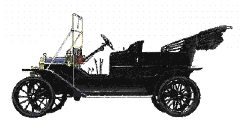Claim: Automaker Henry Ford scavenged junk yards to find out which components had outlasted the useful life of his automobiles, then made those parts out of cheaper materials.
Example: [Barrow, 1995]
There is a story about the late Henry Ford that illustrates the application of this strategy in the car industry. Ford sent a team of agents to tour the scrap-yards of America in search of discarded
Origins: Henry Ford (1863-1947) is an almost mythical figure in American history. His vision of what the
The Model T was specifically engineered to be affordable, reliable, and easy to maintain. The first ones rolled

out of the plant in 1908, and by 1918 half the cars in America were
So where did this anecdote about Ford's alleged penuriousness come from? These days people unfamiliar with Henry Ford the man tend to view him as a penny-pinching plutocrat or an engineering genius who took advantage of every opportunity to lower his manufacturing costs. Both of these pictures are false. Ford was not an infamous robber baron in the mold of turn-of-the-century America magnates such as John Jacob Astor and Andrew Carnegie, men perceived as grasping industrialists who ruthlessly exploited workers and consumers alike in their obsessive quests for wealth and power. And although Ford certainly had his unsavory side (he was a moralistic man who insisted his employees adhere to what he regarded as proper standards of behavior both at work and off the job, as well as a notorious anti-Semite who avidly supported Hitler and who used his power to promulgate the fictitious "Protocols of the Elders of Zion"), he was not a Scrooge-like manufacturing engineer out to shave costs wherever he
could.
Ford was not a money-grubber. Profits were almost unimportant to him; provided he wasn't operating at a loss, he didn't much care if he made a lot or a little. Henry Ford became a millionaire almost as an afterthought to his love for his work. He took great pride in seeing his
Times change, and planned obsolescence is now a fact of modern life. Our legend gives us someone to vilify for this shift, laying that responsibility at the feet of a manufacturer now almost universally disliked. That the legend would better fit just about any other car builder of that era than it does Henry Ford matters little. Someone must have been responsible, therefore let's blame the one we'd like to see pilloried.
Though the legend is almost always positioned as a "let's screw the consumers" tale, on rare occasion it has been presented as an example of intelligent design:
One day, [Henry] Ford sent some of his employees to car junkyards, with instructions to examine the condition of the remaining parts in
[Diamond, 1997]
The basic legend can be twisted to produce other engineering triumph stories:
A proposal was made to armour bombers in the places where the returning planes showed most damage from anti-aircraft fire. One young analyst suggested that instead, the planes should be armoured where the returning bombers showed no damage. He inferred that the planes that did not return were being damaged in the places that the returning planes were not. His suggestion was implemented and an X% reduction in lost planes resulted.
[Collected on the Internet, 1996]
(Some speculate the young analyst might have been Freeman Dyson, but it bears pointing out that legends are commonly ascribed to the famous people deemed most likely to have starred in them. Dyson did work for the operational research section of RAF Bomber Command in 1943, though.)
Barbara "the plane truth" Mikkelson
Last updated: 19 April 2011
Sources: |
Barrow, John. The Artful Universe. Oxford: Clarendon Press, 1995. ISBN 0-19-853996-7.
Diamond, Jared. Why Is Sex Fun?: The Evolution of Human Sexuality. New York: BasicBooks, 1997. ISBN 0-465-03127-7 (p. 114). The Economist. "Forward to Methuselah." 7 January 1995 (p. 65).
